| dc.description.abstract | Hydraulic modeling is a tool that is widely used for studying rivers to find water depth, velocity, wave propagation, water level variations and other hydraulic variables. To achieve accurate results it is often necessary to have a detailed description of the channel topography, which requires extensive data collection. Conventional methods for collecting data are time consuming if a high density is needed and often limited by accessibility or safety. Airborne Light Detection and Ranging (LiDAR) Bathymetry is a remote sensing technique for mapping shallow water bodies which is increasingly used for topo-bathymetric surveys. The purpose of this study was to evaluate Airborne LiDAR Bathymetry (ALB) as a tool for mapping Nordic rivers with different characteristics by comparing data from two rivers. LiDAR data from the deep, dark river Ljungan was compared to the LiDAR data from the clear, shallow river Storåne to evaluate the potential influence of environmental conditions on accuracy and range. The LiDAR data was used to set up a hydraulic model for each of the rivers and run steady and unsteady simulations in one dimension using HEC-RAS. Manual measurements were carried out in the two rivers to assess the vertical accuracy of the LiDAR data, which was found to be less than 10 cm in all areas and did not appear to be affected by physical characteristics or depth. The LiDAR recorded depths up to 3 meters in the dark river and 6 meters in the clear river but the data showed a significant reduction in point density when exceeding depths of 2.5 m and 3 m, respectively. The depth range was mainly limited by the water clarity, but dark substrate or vegetation on the bottom also appeared to influence the depth range. The limited depth range in Ljungan resulted in large areas with missing data and did not provide an accurate hydraulic model. To obtain an accurate model in a dark and deep river like Ljungan it would be necessary to conduct manual measurements or it may be possible to estimate a channel shape based on interpolation of the LiDAR points from the banks. This study found that ALB is an efficient method for mapping rivers with a high density over large areas and can provide accurate hydraulic models with a wide application. | |

